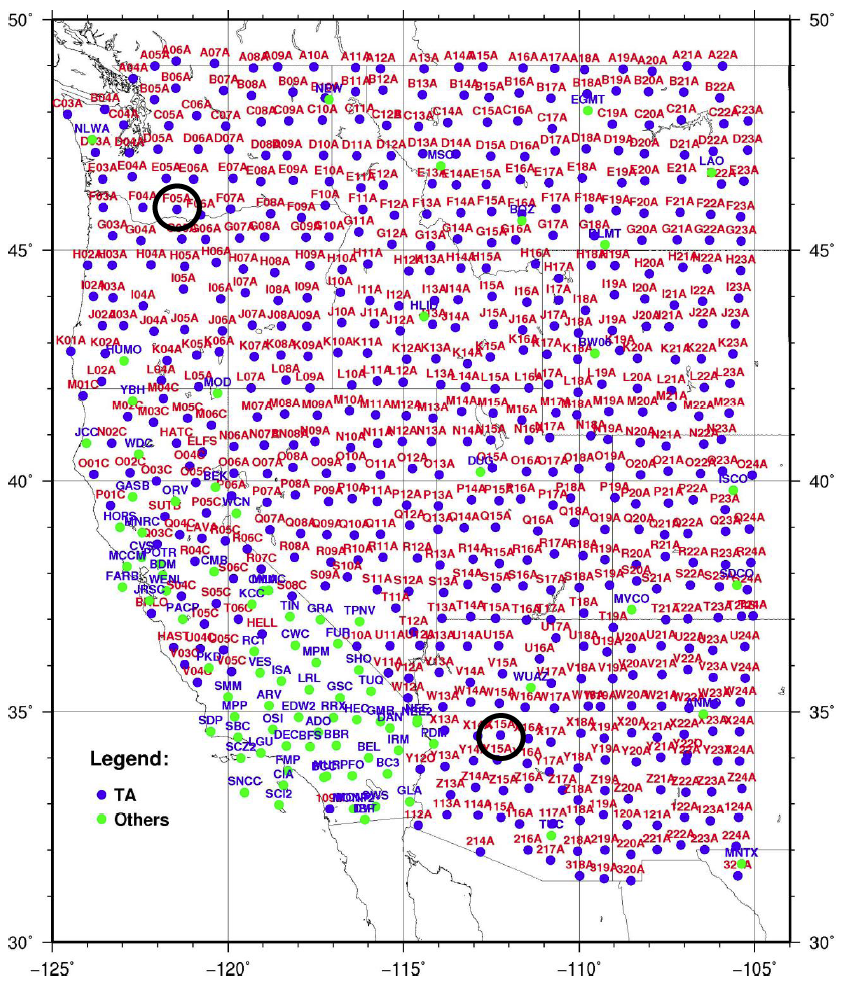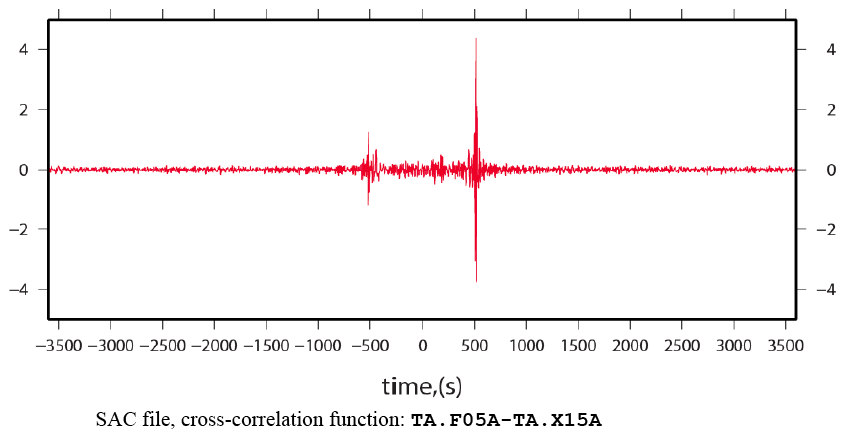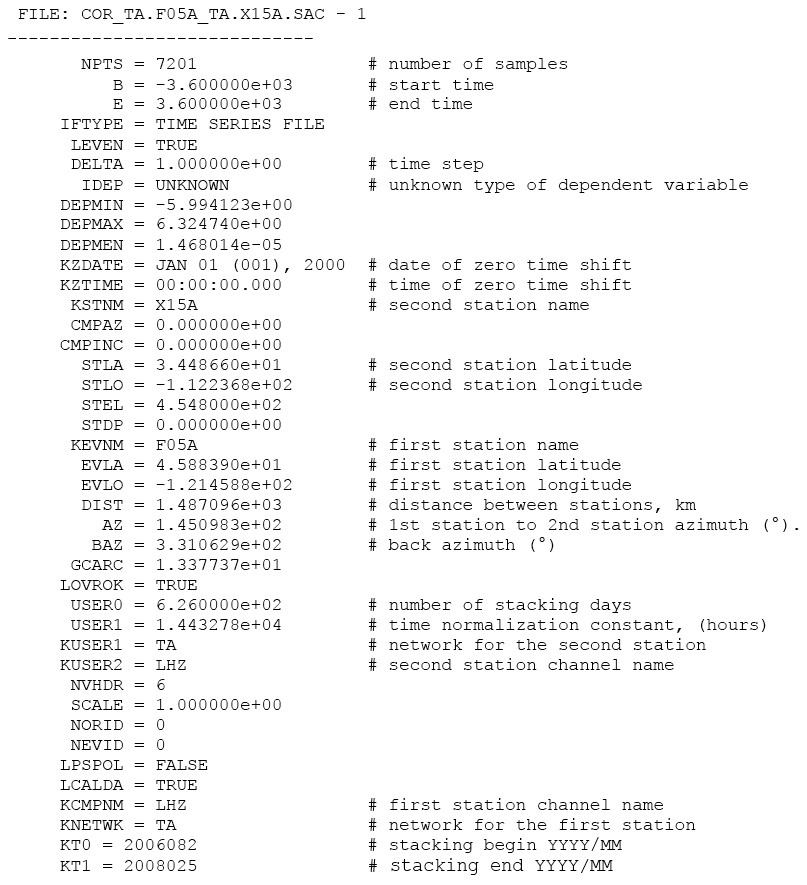Summary
An ambient noise cross-correlation based database of empirical Green's functions (EGFs) of the Western US using USArray Transportable Array (TA) data.
Quicklinks
Description
This page describes the ambient noise cross-correlation product generated at the Center for Imaging the Earth's Interior at the University of Colorado in partnership with the IRIS DMC. 171,120 vertical component (LHZ) ambient noise cross-correlation waveforms, or empirical Green's functions, are available using data from 622 USArray Transportable Array (TA) stations west of 105° W operating between 2005/1/1 – 2010/12/31. Traditional ambient noise data processing procedures (Benson et al., 2007, Lin et al., 2008) were used, but refinements to the method (Lin et al., 2011) were applied to facilitate the interpretation of amplitude measurements. The stacked cross-correlation waveforms (in SAC format) and associated metadata are available in a 5 GB tarball.
Processing
Bensen et al. (2007) and Lin et al. (2008) described what we refer to as the traditional method of ambient noise data processing and this data product uses these procedures. The method breaks into four principal stages: (1) single station data preparation, (2) cross-correlation and temporal stacking, (3) measurement of dispersion curves (performed with frequency-time analysis for both group and phase speeds) and (4) quality control, including error analysis and selection of the acceptable surface wave dispersion measurements. The procedures have been applied to broad-band seismic data around the world and have been shown to produce robust, largely unbiased measurements of Rayleigh and Love wave phase velocities (e.g., Shapiro et al. 2005; Moschetti et al. 2007; Bensen et al. 2008; Lin et al. 2009; Lin and Ritzwoller 2011a; amongst many others). Simulations and, most importantly, comparisons with earthquake data also establish the reliability of the dispersion measurements and maps (e.g., Lin et al. 2008; Yang and Ritzwoller 2008; Ritzwoller et al. 2011). They have been used to produce 3D models of the crust and uppermost mantle for isotropic shear velocity, radial anisotropy, and azimuthal anisotropy (e.g., Yang et al. 2008; Bensen et al. 2009; Moschetti et al. 2010a, 2010b; Lin et al. 2011a).
The ambient noise cross-correlations, or Empirical Green's functions, which define the substance of the data product, arise entirely from the first two stages of this procedure. The principal step in single-station data preparation is ‘temporal normalization’ which is designed to ameliorate the contamination of the ambient noise signals by earthquakes, instrumental irregularities, and non-stationary noise sources near to stations (such as passing storms and high local sea heights). This has been done by applying ‘running absolute-mean’ normalization, which we prefer to sign-bit normalization because it allows for tuning to regional earthquake conditions. In particular, for each day of data we filter the data set between 15 and 50 sec period, compute the absolute mean of the data in a running 80 sec long time window, and normalize the central data point of the unfiltered data by the reciprocal of this mean. In addition, we apply a smooth spectral whitening procedure in a band between 5 and 170 sec prior to cross-correlation in order to minimize contamination from spatially localized microseisms and to broaden the measurement band. Instrument responses are removed and a notch filter around the 26 sec microseism has been applied.
Inter-station distances are a useful quality control metric that exists after the second stage of data processing. We find that inter-station distances greater than 2-3 wavelengths are needed to produce reliable dispersion measurements and this distance is included in the metadata for each cross-correlation. Data gaps introduce the need to define an “effective” time series length. Lin et al. (2011b) show that the square of the rms amplitude of trailing noise provides an accurate proxy for time series length. Here, however, we compute the time series length in hours and include it in the metadata. Cross-correlations are not normalized by this length but if ambient noise amplitudes across inter-stations pairs are to be compared, dividing by this quantity (tsnorm) is recommended.

Map of 622 USArray virtual array (NET=”_US-TA”) stations west of 105° W for which cross-correlations are calculated.
Example waveform

Example of a cross-correlation between TA stations F05A and X15A (highlighted in map). The time series are 492 days in duration. The correspondence between the direction of inter-station propagation and the (positive or negative) lag of the cross-correlation is determined from the order of station names in the cross-correlation identifier, which is F05A-X15A here. The positive lag is a Rayleigh wave traveling from the first station named to the second station, F05A to X15A, and the negative lag is the Rayleigh wave traveling in the opposite direction for the second station named to the first station, X15A to F05A.
An example SAC file header:

Note: For all cross-correlations zero time shift refers to the date/time: 2000/01/01 00:00:00.00
Cross-correlation descriptor file
Cross-Correlation descriptor table
The cross-correlation descriptor table provides metadata unique to each of the 172,120 cross-correlation waveforms:

Note: In this data product, SNR was not calculated for either correlation lag so that the values of the fields snrn and snrp are set to the default values -1.0.
Station site descriptor file
Station site descriptor table
The site descriptor table gives metadata for each station:

Citations and DOIs
To cite the IRIS DMC Data Products effort:
- Hutko, A. R., M. Bahavar, C. Trabant, R. T. Weekly, M. Van Fossen, T. Ahern (2017), Data Products at the IRIS‐DMC: Growth and Usage, Seismological Research Letters, 88, no. 3, https://doi.org/10.1785/0220160190.
To cite the source of ANCC-CIEI, Western US Ambient Noise Cross-Correlations:
- Bensen, G.D., M.H. Ritzwoller, M.P. Barmin, A.L. Levshin, F. Lin, M.P. Moschetti, N.M. Shapiro, and Y. Yang, Processing seismic ambient noise data to obtain reliable broad-band surface wave dispersion measurements, Geophys. J. Int., 169, 1239-1260, https://doi.org/10.1111/j.1365-246X.2007.03374.x, 2007.
To reference the use of Western US Ambient Noise Cross-Correlations:
- IRIS DMC (2012), Data Services Products: ANCC-CIEI, Western US Ambient Noise Cross-Correlations, https://doi.org/10.17611/DP/ANCC.1.
References
Bensen, G.D., M.H. Ritzwoller, M.P. Barmin, A.L. Levshin, F. Lin, M.P. Moschetti, N.M. Shapiro, and Y. Yang, Processing seismic ambient noise data to obtain reliable broad-band surface wave dispersion measurements, Geophys. J. Int., 169, 1239-1260, https://doi.org/10.1111/j.1365-246X.2007.03374.x, 2007.
Bensen, G.D., M.H. Ritzwoller, and N.M. Shapiro, Broad-band ambient noise surface wave tomography across the United States, J. Geophys. Res., 113, B05306, 21 pages, https://doi.org/10.1029/2007JB005248, 2008.
Bensen, G.D., M.H. Ritzwoller, and Y. Yang, A 3D shear velocity model of the crust and uppermost mantle beneath the United States from ambient seismic noise, Geophys. J. Int., 177(3), 1177-1196, 2009.
Lin, F.C. and M.H. Ritzwoller, Helmholtz surface wave tomography for isotropic and azimuthally anisotropic structure, Geophys. J. Int., 186, 1104-1120, https://doi.org/10.1111/j.1365-246X.2011.05070.x, 2011a.
Lin, F.C. and M.H. Ritzwoller, Apparent anisotropy in inhomogeneous isotropic media, Geophys. J. Int., 186(3), 1205-1219, https://doi.org/10.1111/j.1365-246X.2011.05100.x, 2011b.
Lin, F., M.P. Moschetti, and M.H. Ritzwoller, Surface wave tomography of the western United States from ambient seismic noise: Rayleigh and Love wave phase velocity maps, Geophys. J. Int., https://doi.org/10.1111/j1365-246X.2008.03720.x, 2008.
Lin, F.-C., M.H. Ritzwoller, and R. Snieder, Eikonal Tomography: Surface wave tomography by phase-front tracking across a regional broad-band seismic array, Geophys. J. Int., 177(3), 1091-1110, 2009.
Lin, F.C., M.H. Ritzwoller, Y. Yang, M.P. Moschetti, and M.J. Fouch, Complex and variable crustal and uppermost mantle seismic anisotropy in the western United States, Nature Geoscience, Vol 4, Issue 1, 55-61, Jan 2011a.
Lin, F.C., M.H. Ritzwoller, and W. Shen, On the reliability of attenuation measurements from ambient noise cross-correlations, Geophys. Res. Letts., 38, L11303, https://doi.org/10.1029/2011GL047366, 2011b.
Moschetti, M.P., M.H. Ritzwoller, and N.M. Shapiro, Surface wave tomography of the western United States from ambient seismic noise: Rayleigh wave group velocity maps, Geochem., Geophys., Geosys., 8, Q08010, https://doi.org/10.1029/2007GC001655, 2007.
Moschetti, M.P., M.H. Ritzwoller, and F.C. Lin, Seismic evidence for widespread crustal deformation caused by extension in the western USA, Nature, 464, Number 7290, 885-889, 8 April 2010a.
Moschetti, M.P., M.H. Ritzwoller, F.C. Lin, and Y. Yang, Crustal shear velocity structure of the western US inferred from amient noise and earthquake data, J. Geophys. Res., 115, B10306, https://doi.org/10.1029/2010JB007448, 2010b.
Ritzwoller, M.H., F.C. Lin, and W. Shen, Ambient noise tomography with a large seismic array, Compte Rendus Geoscience, 13 pages, https://doi.org/10.1016/j.crte.2011.03.007, 2011.
Shapiro, N.M. M. Campillo, L. Stehly, and M.H. Ritzwoller, High resolution surface wave tomography from ambient seismic noise, Science, 307(5715), 1615-1618, 11 March 2005.
Yang, Y. and M.H. Ritzwoller, The characteristics of ambient seismic noise as a source for surface wave tomography, Geochem., Geophys., Geosys., 9(2), Q02008, 18 pages, https://doi.org/10.1029/2007GC001814, 2008.
Yang, Y., M.H. Ritzwoller, F.-C. Lin, M.P. Moschetti, and N.M. Shapiro, The structure of the crust and uppermost mantle beneath the western US revealed by ambient noise and earthquake tomography, J. Geophys. Res., 113, B12310, 2008.
Credits
- This product was generated by Mikhail Barmine and Michael Ritzwoller at the Center for Imaging the Earth's Interior (CIEI) at the University of Colorado at Boulder and was supported by the Incorporated Research Institutions for Seismology under their Cooperative Agreement No. EAR-0733069 with the National Science Foundation.
- Alexander Hutko
Timeline
- 2012-06-01
- WUS ANCC online
Contributors
Mikhail Barmine
Center for Imaging the Earth’s Interior






